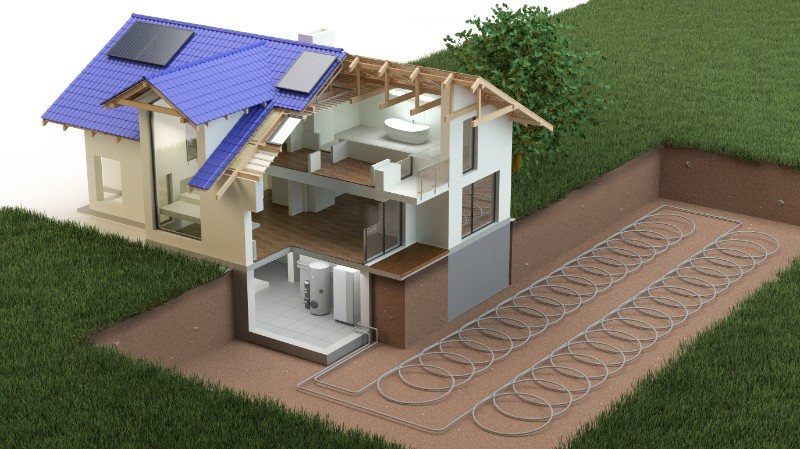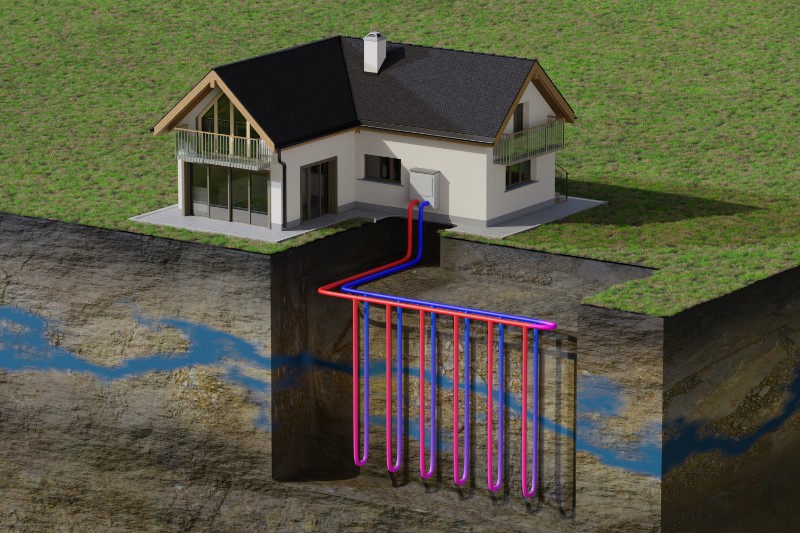The United States generates the most geothermal electricity in the world—more than 3.7 gigawatts. That’s enough to power about 2.7 million U.S. homes. Presently only 0.4% of USA power comes from geothermal energy production. Analysts suggest that the USA could easily increase its overall geothermal energy production by over 20 times its current production within the next two decades.
To generate power from geothermal systems, three elements are needed:
Heat—Abundant and sustained heat found in rocks deep underground, varying by depth, geology, and geographic location.
Fluid—Sufficient subsurface fluid to carry heat from the rocks to the earth’s surface.
Permeability—abundant small pathways within the geothermal anomaly to allow movement of fluid through the hot rocks.
The presence of hot rocks, fluid, and permeability underground creates natural geothermal systems. Small underground pathways, such as fractures, conduct fluids through the hot rocks. In geothermal electricity generation, this fluid can be drawn as energy in the form of heat through wells to the earth’s surface. At the surface, that energy is converted to steam, which drives turbines that produce electricity.
Conventional hydrothermal resources naturally contain all three elements. Sometimes, though, these conditions do not exist naturally—for instance, the rocks are hot, but they lack permeability or sufficient fluid flow. Enhanced geothermal systems (EGS) use human-made reservoirs to create the proper conditions by injecting fluid into the hot rocks. This reopens fractures and enhances the size and connectivity of fluid pathways. Once created, an EGS functions just as a natural geothermal system does: The now-available fluids carry energy to the surface through wells, driving turbines and generating electricity. By overcoming natural limitations in the subsurface, EGS can expand geothermal energy nationwide. The 2019 GeoVision analysis concluded that, with advancements in EGS, geothermal could power more than 40 million U.S. homes by 2050 and provide heating and cooling solutions nationwide.
Geothermal Power Plants
Geothermal power plants draw fluids from underground reservoirs to the surface to produce steam. This steam then drives turbines that generate electricity. There are three main types of geothermal power plant technologies: dry steam, flash steam, and binary cycle. The type of conversion is part of the power plant design and generally depends on the state of the subsurface fluid (steam or water) and its temperature.
In addition to these three power production systems, there are thermal systems that primarily use the stable earth temperatures to provide heating and cooling systems for commercial, residential, and greenhouse applications. These systems work by conveying either liquid or air through the earth to take advantage of the earth’s natural ability to store thermal energy and then utilize it to regulate temperature.
Dry Steam Power Plant
Dry steam plants use hydrothermal fluids that are already mostly steam, which is a relatively rare natural occurrence. The steam is drawn directly to a turbine, which drives a generator that produces electricity. After the steam condenses, it is frequently reinjected into the reservoir.
Dry steam power plant systems are the oldest type of geothermal power plants, first used in Lardarello, Italy, in 1904. Steam technology is still relevant today and is currently in use in northern California at The Geysers, the world’s largest single source of geothermal power.
Flash Steam Power Plant
Flash steam plants are the most common type of geothermal power plants in operation today. Fluids at temperatures greater than 182°C/360°F, pumped from deep underground, travel under high pressures to a low-pressure tank at the earth’s surface. The change in pressure causes some of the fluid to rapidly transform, or “flash,” into vapor. The vapor then drives a turbine, which drives a generator. If any liquid remains in the low-pressure tank, it can be “flashed” again in a second tank to extract even more energy.
Binary-Cycle Power Plant
Binary-cycle geothermal power plants can use lower temperature geothermal resources, making them an important technology for deploying geothermal electricity production in more locations. Binary-cycle geothermal power plants differ from dry steam and flash steam systems in that the geothermal reservoir fluids never come into contact with the power plant’s turbine units. Low-temperature (below 182°C/360°F) geothermal fluids pass through a heat exchanger with a secondary, or “binary,” fluid. This binary fluid has a much lower boiling point than water, and the modest heat from the geothermal fluid causes it to flash to vapor, which then drives the turbines, spins the generators, and creates electricity.
https://geothermal-energy-journal.springeropen.com/articles/10.1186/s40517-015-0036-2
GFES believes that because of these resource characteristics and market drivers, geothermal will become the most highly coveted renewable energy source.
The GFES has strategically acquired assets in Western USA which are located in areas defined as Known Geothermal Resource Areas (KGRA) which are close to available transmission infrastructure with available capacity. The U.S. Geological Service defines KGRAs as locations that have proven potential to support geothermal power. In addition, GFES understands the importance of a source located on available transmission lines feeding population areas with high energy needs. The company’s lead project is located on one of the largest thermal anomalies in the western US and the area is estimated to have a total megawatt capacity of over 275 MW.
Geothermal Heat Pump Systems and Earthtube Systems
https://www.energy.gov/energysaver/geothermal-heat-pumps
Geothermal heat pumps (GHPs), sometimes referred to as GeoExchange, earth-coupled, ground-source, or water-source heat pumps, have been in use since the late 1940s. They use the relatively constant temperature of the earth as the exchange medium instead of the outside air temperature.
Although many parts of the country experience seasonal temperature extremes — from scorching heat in the summer to sub-zero cold in the winter—a few feet below the earth’s surface the ground remains at a relatively constant temperature. Depending on latitude, ground temperatures range from 45°F (7°C) to 75°F (21°C). Like a cave, this ground temperature is warmer than the air above it during the winter and cooler than the air in the summer. The GHP takes advantage of these more favorable temperatures to become high efficient by exchanging heat with the earth through a ground heat exchanger.
As with any heat pump, geothermal and water-source heat pumps are able to heat, cool, and, if so equipped, supply the house with hot water. Some models of geothermal systems are available with two-speed compressors and variable fans for more comfort and energy savings. Relative to air-source heat pumps, they are quieter, last longer, need little maintenance, and do not depend on the temperature of the outside air.
A dual-source heat pump combines an air-source heat pump with a geothermal heat pump. These appliances combine the best of both systems. Dual-source heat pumps have higher efficiency ratings than air-source units, but are not as efficient as geothermal units. The main advantage of dual-source systems is that they cost much less to install than a single geothermal unit, and work almost as well.
Earthtubes, earth–air heat exchanger (EAHE), is another promising technique which can effectively be used to reduce the heating/cooling load of a building by preheating the air in winter and vice versa in summer. In the last two decades, a lot of research has been done to develop analytical and numerical models for the analysis of EAHE systems. The method to calculate the earth’s undisturbed temperature (EUT) and more recently developed correlations for friction factor and Nusselt number are used to ensure higher accuracy in the calculation of heat transfer. The developed equations enable designers to calculate heat transfer, convective heat transfer coefficient, pressure drop, and length of pipe of the EAHE system. A longer pipe of smaller diameter buried at a greater depth and having lower air flow velocity results in an increase in performance of the EAHE systems. (https://geothermal-energy-journal.springeropen.com/articles/10.1186/s40517-015-0036-2)
Earthtubes (EAHE systems) are a highly recommended low-tech, sustainable, non-electric, zero-energy, geothermal passive solar heating and solar cooling systems. Earthtubing utilizes conventional, thin wall plastic sewer drain vent pipe to passively pre-heat your home’s fresh air intake with zero-energy consumption. Filtered fresh air enters a series of non-porous pipes embedded around the interior of your home’s foundation, absorbing energy from the surrounding soil, moderating the temperature of fresh air intake. When done correctly, air drafts naturally through your earthtubes for a truly sustainable, non-electric, zero-energy, passive geothermal system that perfectly supplements a high thermal mass HTM home’s back-up heating and cooling system. (https://www.thenaturalhome.com/earthtube/)


